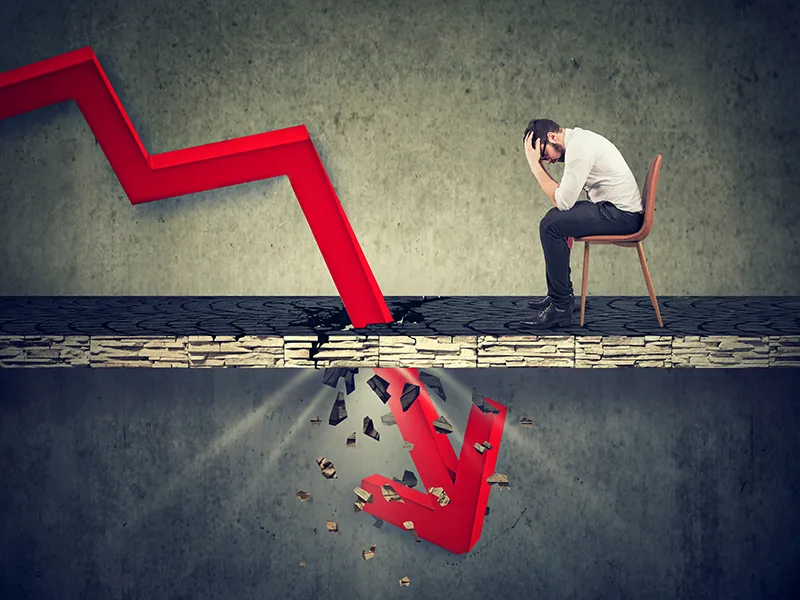
The stock markets are inherently volatile in nature is a fact that cannot be ignored or escaped. It is also true that it is this volatility that drives the market and makes it move in cycles of bullish and bearish trends. When we talk about stock market crashes, the crash of 2020 is the most recent one. Since the start of the pandemic, we have seen the market react to this news in a cycle of absolute wipeout to a rapid bounce back. But the history of stock markets is filled with multiple stock market crashes that have happened at different intervals.
Given below is a brief history of the stock market crashes in India and the related details.
When is the stock market said to have crashed?
The term stock market crash is something that every participant of the stock markets has heard. But how many may know the true meaning of it? As per Financial Times, the stock market is said to have crashed when they fall in double digits over a period of 5 minutes. However, in India, the stock market is said to have crashed in any of the following cases.
- When Nifty falls more than 10% over a period of 20 days.
- When the difference between the high on a day and the low on the next trading day is more than 10%.
- When NIfty falls more than 5% over a period of 9 days.
What are the major stock market crashes in India?
Now that we know the true meaning of stock market crashes, let us go through a brief history of such crashes in India.
a. Stock market crash of 1865
The earliest recorded stock market crash in India had occurred in the year 1865. There was no formal stock exchange in India at that time. However, the Parsi and the Gujarati traders would do mutual trading at the junction of Rampart Row and Meadows Street. Against the backdrop of the American Civil war, the stock prices of cotton of Indian companies increased due to its high demand. The earnings of this boom were invested in the stock market creating a frenzy of buying and selling as well as an increase in the speculation transactions. At the peak of such speculation, when the Civil War ended, it led to a crash in the demand and prices of cotton creating a snowball effect. This was the first stock market crash leading to a massive massive wipeout where the buyers and sellers alike defaulted.
b. Stock market crash of 1992
The 1992 stock market crash is perhaps the most famous of all times. It was the first time a major scam has touched the Indian stock market to the tune of Rs. 5,000 crores approximately. The stock market crash of 1992 can be attributed to the planned security scam done by Mr. Harshad Mehta. BSE had a steep fall of over 12% approximately. The resultant bear market in the face of the scam lasted for a period of two years. It wiped out crores of rupees from the banking sector and is considered to be one of the worst periods of Indian stock markets.
c. Stock market crash of 2004
The stock market crash of 2004 can be attributed to the sudden fall of the NDA government resulting in a crash of 15.52% in the Sensex. It is the largest fall in the history of Indian Stock markets in terms of percentage. The fall of the Government triggered the sale of shares by UBS an institutional investor fearing political instability.
d. Stock market crash of 2008
This was another dark period in the Indian stock markets when the markets tumbled on the backdrop of the fears of a recession in the US markets along with other contributing factors like a drop in the interest rates, lack of investor confidence, selling of shares, and exiting the risky emerging markets by the FIIs and Foreign Hedge Funds. The stock markets saw a continuous crash all throughout the year and took almost 2 years for the market to revive and reach the pre-crash levels in September 2010.
e. Stock market crash of 2015
The markets crashed again in 2015 on the backdrop of the falling Chinese economy after a good run from the fall of 2008. The stock markets in Shanghai fell by a staggering 8.5% which triggered a fall of the Indian stock markets. Other contributing factors to this fall were the poor earnings by major Indian companies and management doubts along with poor monsoon.
f. Stock market crash of 2016
By the start of 2016, the Indian stock markets had seen a collective fall of approximately 26% over a period of 11 months. The cumulative reasons for this fall were the increase in the banks’ NPAs, the decreasing crude oil prices, the slowing of the Chinese economy, and general global weakness and lack of investor confidence across the world.
Apart from this, the announcement of demonetization in 2016 led to another crash of markets in the same year. The Sensex dropped a whopping 6% and Nifty dropped by 541 points. The crash was driven by the demonetization drive along with other factors like the presidential elections in the US, a collective fall in the major Asian stock markets (Hang Seng, Nikkei, and Shanghai Composite).
g. Stock market crash of 2020
The fall of stock markets in 2020 is the latest major fall of the Indian stock markets and can be attributed solely to the Cononavorus Pandemic that originated in China. The stock markets fell continuously for a period of 5 days making it the worst fall since the crash of 2009. The tumbling of the markets due to the pandemic along with the possibility of the crash of Yes Bank led to a massive wipeout of the investor’s wealth. The pandemic led to a global crash of stock markets but it is interesting to note that the markets revived much quicker than anticipated and are continuing on a bullish run.
How can investors save themselves from a stock market crash?
The crash of the stock markets is an event that can take a majority of investors by surprise. It is important that the investors (especially retail investors) take some necessary steps to safeguard their interest in such events and avoid maximum losses. Some of the common tips that can help investors in such situations are highlighted below.
- The first and foremost tip is to diversify the portfolio so the risk is spread. When the portfolio includes defensive stocks and non-cyclical stocks, they usually act as a buffer in the backdrop of a crash.
- Setting a stop loss is the key to protecting the capital from being wiped out. It is therefore important that traders use it efficiently so as to minimize their losses in a sudden fall of markets.
- Stock markets downfall happen overnight. They are often backed due to some major issues like political uncertainty, some major outbreaks (like Covid 19). It is therefore important to look out for such factors and best to sell short-term investments in such scenarios to avoid maximum losses.
- Stock markets are a combination of bull and bear markets. When the stock markets crash, retail investors often liquidate their investments at throwaway prices as a means to limit their losses. It is however a wrong practice. Quality stocks always revive and therefore, it is important to hold on to them and not book the losses in the face of uncertainty.
Conclusion
Stock market crashes wipe out a majority of investors’ wealth and they have to start from scratch to rebuild their portfolio. They are often unavoidable and triggered by major events whether on a national or international level. An important way to tide over such market crashes is to keep a cool head and act rationally rather than make impulsive decisions.
FAQs
The best time to start investing in stock markets is at the earliest usually in the 20s. This will allow the investors to gain the maximum advantage of compounding.
The fall of stock markets on 21st January 2008 is named ‘Black Monday’ by the media. It led to a stop of trading on BSE for an hour.
A few other major stock market crashes in India are in the year 1991 (led by economic liberalization), the crash of 2006 (when BSE fell by 826 points), the crash of 2009 (BSE fell by 869 points), the crash of 2018 (led due to the Budget of 2018 when LTCG to be taxed ta 10% was proposed).
Stock markets may tumble dramatically during a crash but have always bounced back. When the markets revive, they help the equities gain momentum and can provide good returns in the long term over a period of 10-15 years. Hence, it is not advisable to exit long-term investments due to the fear of stock market crashes.

























